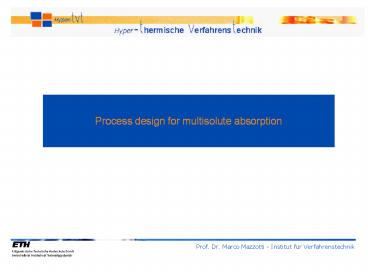Process design for multisolute absorption - PowerPoint PPT Presentation
Title:
Process design for multisolute absorption
Description:
Title: No Slide Title Author: Paredes Last modified by. Created Date: 3/12/2002 10:11:29 PM Document presentation format: On-screen Show Company – PowerPoint PPT presentation
Number of Views:54
Avg rating:3.0/5.0
Title: Process design for multisolute absorption
1
Process design for multisolute absorption
Prof. Dr. Marco Mazzotti - Institut für
Verfahrenstechnik
2
1. Variables
Once temperature, pressure and initial
composition of the solvent are set we can
consider them as data. This is a list of known
variables
yj,1
G
L
Data and set values j 1,..k..,c
Specifications k key
Unknowns j 1,..k..,c
yk,1
xj,o
Temperature, T
Gas final composition, yk, 1
Solvent flow rate, L
Pressure, p
Number of stages, n
Gas flow rate, G
Gas final compositions, yj, 1
Gas initial compositions, yj, n1
Solvent final composition, xj, n
Solvent initial composition, xj,o
T
p
Equilibrium data, y mj xj
y mj x
n
xj, n
yj, n1
G
L
3
2. From single solute to multisolute absorption
Up to this point we have been restricted to cases
where there is a single solute to recover. Both
the stage-by-stage McCabe-Thiele procedure (for
linear and non-linear equilibrium) and the
Kremser equation (for linear equilibrium) can be
used for multisolute absorption if certain
assumptions are valid.
The single solute analysis by the Kremser
equation requires...
1. Systems that have linear equilibrium
2. Systems that are isothermal
3. Systems that are isobaric
4. Systems that have negligible heat of
absorption
5. Systems that have constant flow-rates
These assumptions are still required. A new
assumption must be added for the multisolute case
6. Solutes are independent of each other
So the equilibrium for any solute does not depend
on the amounts of other solutes present. This
assumption requires dilute solutions.
4
3. Solving the multisolute problem
The consequence of assumption 6 is that we can
solve the multisolute problem once for each
solute, treating each problem as a single-solute
problem. This is true for the Kremser equation
(assuming linear equilibrium) and for the
stage-by-stage solution method (any equilbrium
relation).
Usually one outlet composition for one of the
components is fixed. This component is called key
component and is the specification of the
problem. It is designed by the letter k.
The equilibrium information for each component is
required, in order to solve the problem. Lets
consider the absorption problem of c components,
all of them systems of linear equilibrium
...
...
j 1
j 2
j k
j c
m1 gt m2 gt ...gt mk gt...gt mc
5
Now, for the key component we can write the
operating line as usual (note that the slope of
the operating line does not depend on the
specific solute
The problem can be solved for k component as
usual, either using Kremser or the graphical
construction
yk
j k
Choosing A...
yk,n1
yk,4
Calculating the slope of the operating line
yk mk xk
L /G
yk,3
Using Kremser equation
yk,2
yk, 1
xk
xk,2
xk,3
xk,4
xk,o
xk,1
6
Once the number of stages has been found from the
key solute, k, the concentrations of the other
solutes can be determined by solving (c-1) fully
specified simulation problems.
This means that the number of stages is known and
the outlet compositions have to be calculated.
This problem is similar to the one we have
already discussed and called simulation
problem. The operating lines have for every
solute the same slope (L/G).
If we consider the next example, the number of
stages found for the key component must be drawn
for the other components. Graphically, this
means...
...
j 1
j 2
j c
y
y
y
yc,n1
y2,n1
y1,n1
yc mc xc
y1 m1 x1
y2 m2 x2
y1,1
y2,1
yc,1
x
x
x
7
While analytically, the following steps are
followed for all the components, j, but k
So the outlet composition in the gas can be
calculated
8
Have a look to the design Flowsheet































